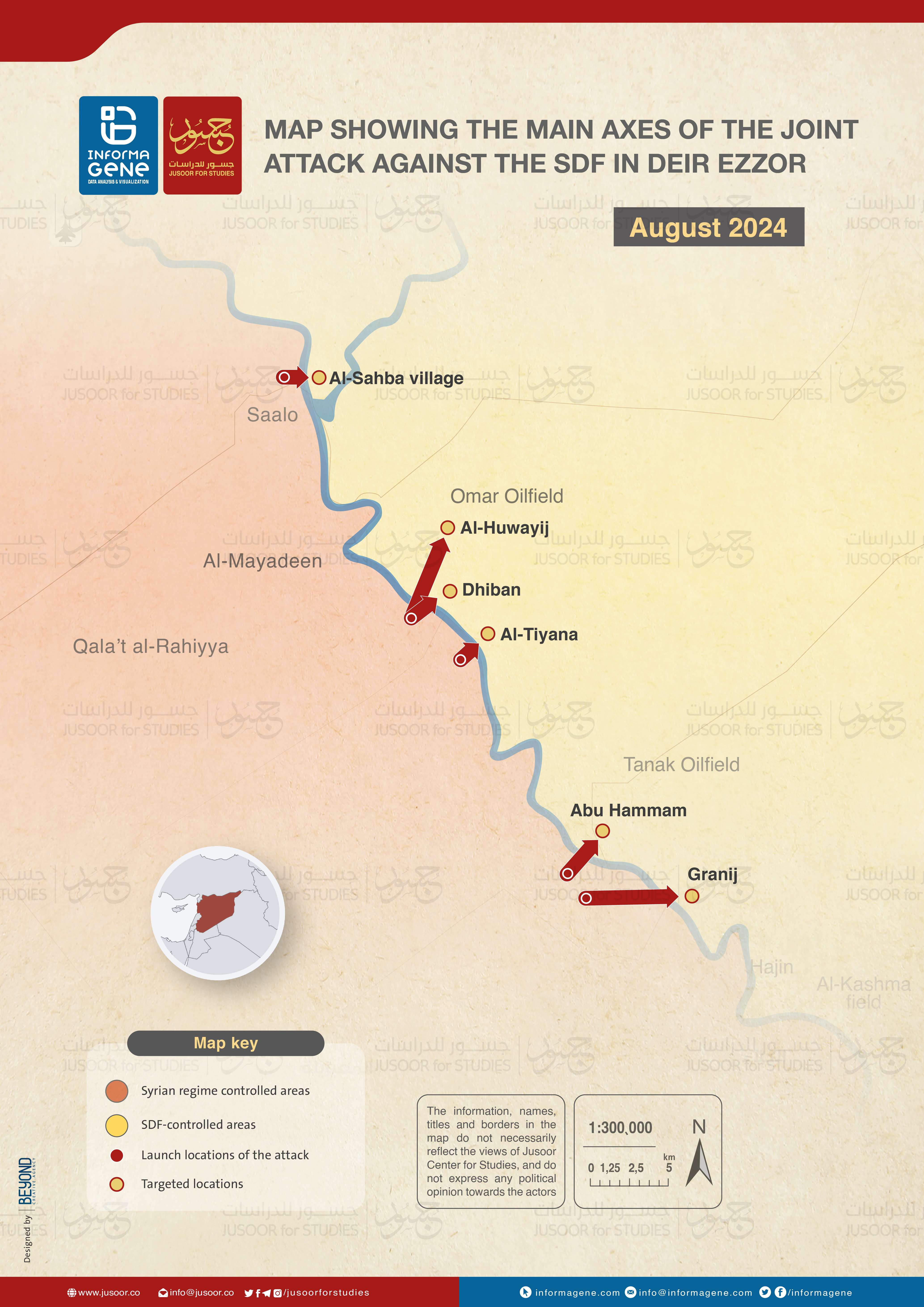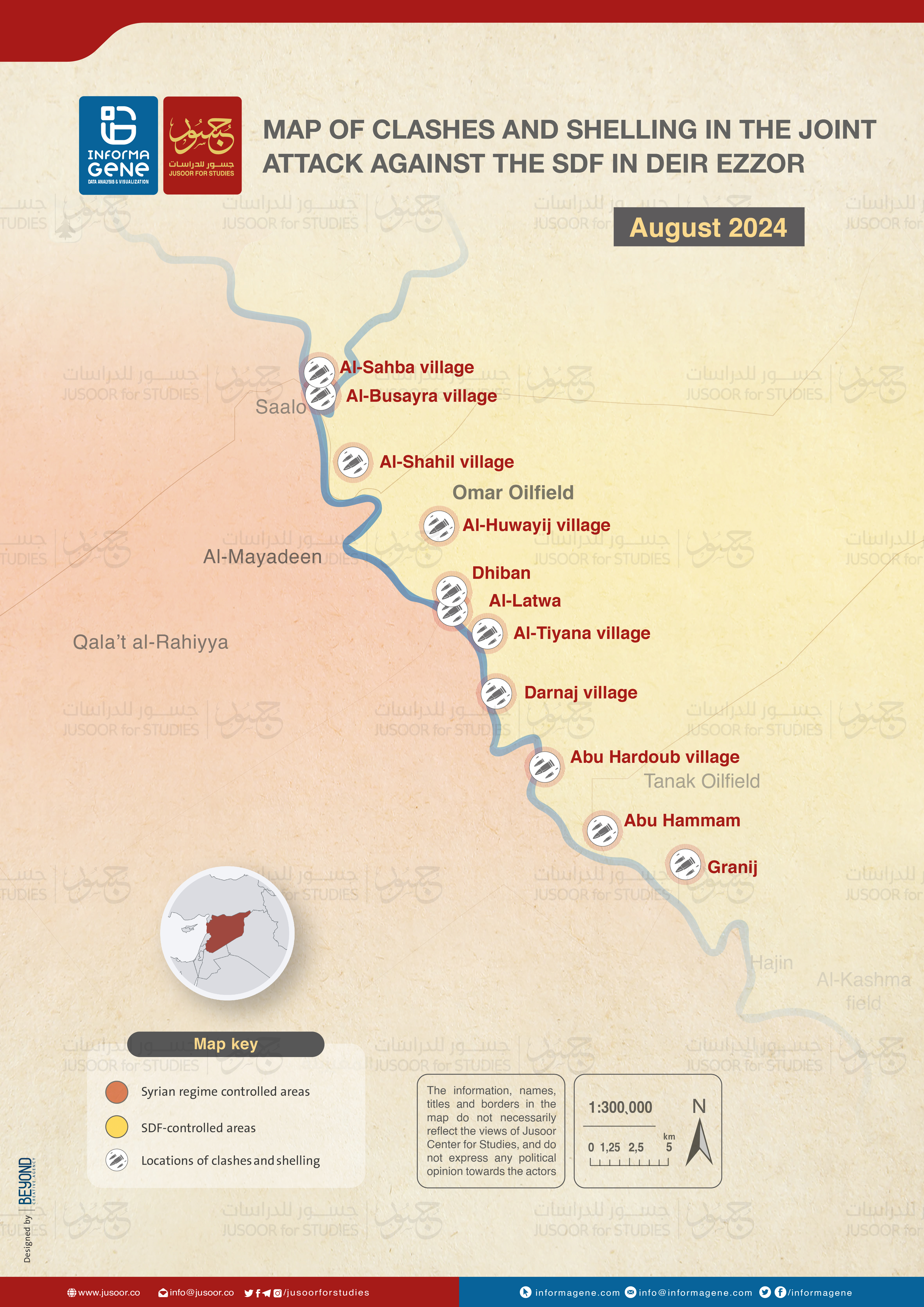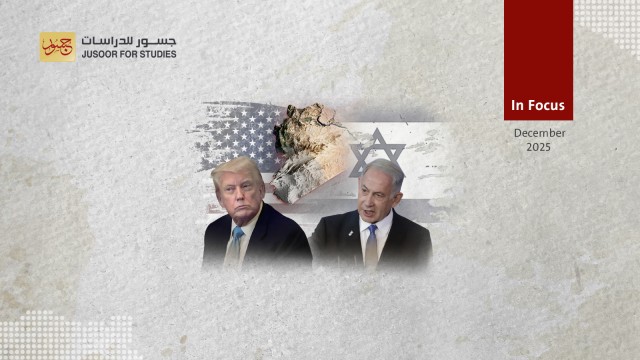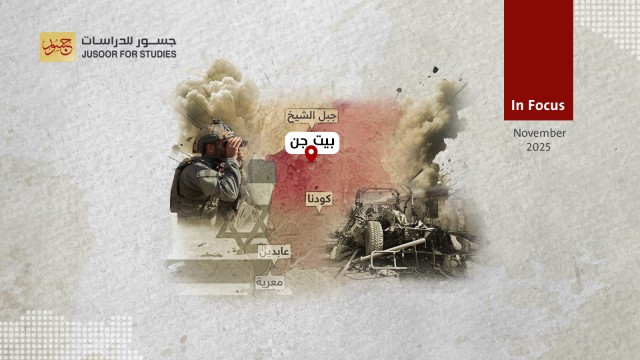Regime and Allies Attack SDF in Deir Ezzor
On the morning of, August 7, armed groups affiliated with the Iranian Revolutionary Guard Corps (IRGC), Syria’s National Defense Forces and a pro-regime tribal force known as the Tribal Army ( Quwwat Muqatili al-‘asha’ir ) carried out a coordinated attack against Syrian Democratic Forces (SDF) bases in several cities and towns in eastern Deir Ezzor province.
The most violent attack by loyalist militias since the establishment of the Tribal Army in September 2023, it was commanded by a joint operations room that included IRGC advisors, Syrian regime intelligence officers, and the NDF.
After most SDF forces had withdrawn under missile and mortar fire, the attackers deployed in those areas for several hours, before withdrawing in the face of an SDF counterattack relying on major reinforcements of troops and materiel. The SDF were also helped by drones and helicopters belonging to international coalition forces which tracked and targeted the attackers, forcing them to withdraw to the regime-held southern bank of the Euphrates River.
The attack killed three civilians and wounded others, as well as killing two pro-regime fighters and five SDF troops. It also wounded some of their comrades, who were transported to the city of Qamishli by international coalition helicopters.

The SDF issued statements accusing the regime’s intelligence agencies of orchestrating the attack, and responded by laying siege to its facilities in the cities of Hasakeh and Qamishli, arresting some 20 regime personnel at checkpoints in the two cities and launching at least one incursion into regime-held areas of rural Deir Ezzor.
Following the escalation, Russia intervened to mediate between the SDF and the regime, holding meetings between military and security officials from both sides, overseen by the commander of Russian forces operating in Syria.
At the time of writing, the Russian-led talks were ongoing, even as the two sides continued to exchange fire in Deir Ezzor and carry out reciprocal incursions and shelling on both banks of the Euphrates. Simultaneously however, the negotiations had succeeded in persuading both regime forces and the SDF to implement confidence-building steps. The SDF lifted its siege against the regime’s two security quarters, and a hostage exchange saw the SDF release regime officers and other personnel held while the regime freed a number of SDF fighters captured during the latest attack. It also released the former commander of the Manbij Military Council, Abdul Rahman Al-Bannawi, who had been arrested in early August 2024 as he headed to the city of Aleppo for medical treatment.
Varying motives
The timing of the attack, the subsequent escalation against the SDF, and the make-up of the operational command reflect the close involvement of Iranian and regime forces. However, the fact that Iran did not take part in the negotiations indicates that each of the three parties to the attack had different motivations, as follows:
For Iran, using local militias led by the Tribal Army to target the SDF-held areas home to American bases was a low-cost, low-risk way of striking at Israel and U.S. interests. Iran prefers this option over directly targeting these bases with missiles or drones, a policy it has almost completely halted since February, when the U.S. bombed militia sites in Syria and Iraq with long-range bombers, and the “Islamic Resistance in Iraq” militias that were coordinating these attacks entered a truce, guaranteed by the Iraqi government.
For Russia, the attack represented a new arena in which to pressure the U.S., which leads the international coalition, by provoking instability in the areas where it is deployed, targeting its local ally (the SDF), and pressuring it to enter negotiations. Moscow sees this as an opportunity to secure additional military, security or economic gains for its own forces or for the Syrian regime. Damascus is focused on the potential economic gains from an increase in its share of the crude oil that the SDF provides to areas under its control, or the imposition of fixed fees or taxes on oil fields or wells in SDF-held areas, especially Deir Ezzor, in exchange for the regime halting its attacks on these areas, which have significantly disrupted oil production.
The regime also sees the attack as a display of force, with two aims. The first is to show off its ability to apply pressure on the SDF and international coalition forces, alongside militias operating within the Iran-led “Axis of Resistance”, especially as it had played almost no role in such actions on its southern border since the start of the Gaza conflict. The second is its desire to strengthen its position as Russia attempts to mediate between it and Türkiye. Damascus wants to highlight its ability to target the SDF and its autonomy project, which Ankara considers the primary threat to its national security.
As for the Tribal Army and its commander Ibrahim al-Hifl, its role was largely functional, and directed by the regime through its head of general intelligence, Hussam Luqa, who met al-Hifl about a week before the attack was launched. The attack made use of Al-Hifl’s tribal clout and the symbolism of his fight against the SDF since August 2023, as a cover for the activities of Iranian and regime-affiliated militias. This was evident in the fact that only Al-Hifl and his allies made public statements about the attack and the subsequent escalation, while the Tribal Army’s flag and logo were the only symbols present in the accompanying media coverage.
Al-Hifl was keen to emphasize that he bears no affiliation with any party, and said he simply wanted to end the SDF’s presence in the Jazira region of Syria, urging Arab tribes to unite towards this goal. He refrained from mentioning the other groups participating in the attack and their known affiliations with the regime and Iranian Revolutionary Guard Corps (IRGC).
Moreover, the attack amounted to sabotage against negotiations between the Democratic Union Party (PYD) and the local community in Deir Ezzor, including tribal representatives who support the SDF-PYD autonomous region project. A central goal of this process had been to isolate Ibrahim al-Hifl and his fighters from the region and end their influence there, by rebuilding PYD-affiliated civil and military councils and strengthening their role in Deir Ezzor—but according to the party’s vision and interests, and without any local actors being able to change or influence it.
This disparity in the goals and motives of the various forces involved in the attack on the SDF may help explain why the Russian-led talks have achieved little beyond limited security measures by both parties in Al-Hasakeh province, without ending the escalation or taking any measures in the main theater of the attack in Deir Ezzor. Another possible reason for the negotiations’ lack of success is that Iran did not take part, despite the fact that its militias were the main actor in the offensive and the subsequent clashes.
A New Phase for the SDF?
In summary therefore, the coordinated attack against the SDF can be considered over, but with subsequent, ongoing clashes and continued arrivals of reinforcements to the militias that took part, it is likely to be repeated. Indeed, it could mark a new phase in the relationship between the SDF and coalition forces on the one hand, and the Syrian regime, Russia, and Iran on the other.
The ultimate result of the attack will depend on the outcome of the Russian-led negotiations and the extent to which Iran, which is not directly involved at this point, engages with them. The SDF, for its part, has leaked most of its demands, such as that the Tribal Army be dismantled, and that Iranian and affiliated local militias be kept away from the riverbanks opposite SDF-controlled areas and coalition bases in Deir Ezzor.
The difficulty situation the SDF now faces may force it to make significant military or economic concessions to Russia and the regime in the areas under its control, in order to rein in the current escalation and to prevent new attacks against its forces and areas under its control in Deir Ezzor.










